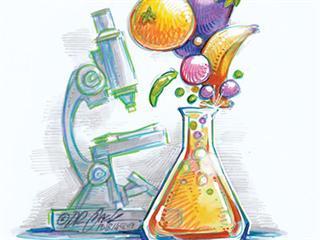
The Bio-Economy Strategy aims to strengthen agricultural bio-sciences’ innovation in order to ensure food security, enhance nutrition and health, and create jobs through the expansion and intensification of sustainable agricultural production and processing.
Strengths and opportunities
Primary agriculture contributes about 2,5% to South Africa’s gross domestic product (GDP) and about 8% to formal employment. Agriculture has strong links to the broader economy, with the agro-industrial sector contributing about 12% to GDP. The primary production, secondary input and agro-processing sectors together form the ‘agro-food’ complex, an important economic sector. While the country produces enough food to meet local needs on a national scale, there is widespread household food insecurity.
South Africa has well-established maize, sugar cane, wine and deciduous fruit industries that serve the local and export markets. These industries depend on research, development and innovation to remain competitive. Historically, the Agricultural Research Council (ARC) and its institutes, as well as universities, provided a strong research and technology development base to support the primary agricultural industry. However, agricultural extension work is poorly resourced and needs strengthening.
Recently, a few small local companies commercialised bio-pesticides and innovative new crop propagation and post-harvest technologies. However, ARC remains government’s primary instrument for driving agricultural innovation, and significant reinvestment is required to maintain and grow sustainable crop yields.
South Africa has a rich biodiversity that includes indigenous crops and animals that are adapted to harsh local conditions yet still offer superior nutrition. Local knowledge has helped to unlock the value of these indigenous resources. However, a growing population and limited water and arable land require new approaches to meeting the country’s needs.
Geopolitically, the development and encouragement of agro-innovation across Africa should be viewed as a longer-term outcome of this strategy. African nationals’ tertiary education remains critical. Where appropriate, regional regulations for the registration and introduction of new varieties of crops, livestock and biocontrol agents, must be consolidated for sustainable and competitive agriculture across the continent. Responsible genetic engineering remains critical for agriculture and in South Africa presents a significant competitive opportunity for sector development.
Interventions
Of the three sectors identified as crucial to the bio-economy – agriculture, health, industry and the environment – agriculture currently has the highest economic impact. Research and development in this sector will help to ensure food security, improve general nutrition and create jobs both in agriculture and research, and will require strong private-sector involvement.
Indigenous crops, coupled with consumer demand for ‘natural’ products, present opportunities for South Africa to capitalise on its biodiversity and capture niche markets. Indigenous products that show promise include the natural sweetener Monatin, fortified sorghum, rooibos and honeybush. Short- to medium-term strategic interventions to enhance the agricultural sector’s competitiveness are the following:
Co-ordinating committee: A committee of representatives from government, industry and academia should
be established to guide agro-innovation. The committee should prioritise resource allocation, monitor research and development progress, and recommend initiatives to enhance and develop the sector within the scope of the Department of Science and Technology’s implementation plan.
Agro-innovation hubs: The skills and solutions that emerge from biotechnology research should be effectively transferred to emerging, small-scale and commercial farmers. Regional agro-innovation hubs can act as catalysts for the collective enhancement of production, agro-processing and marketing by farmers, scientists and innovators. The role of indigenous knowledge systems (IKS) are critical in enhancing grassroots innovation for food security and improving quality of life.
Crop and livestock improvement: Crop and livestock improvement is a basic requirement for the agricultural sector. Research and development programmes must focus on the commercial sector’s indigenous crops and livestock to develop traits appropriate to emerging and subsistence farmers.
Agro-processing initiatives: Agro-processing reduces post-harvest losses, extends shelf life and improves the quality and safety of foods. Significant opportunities exist for agro-processing to add value to agricultural produce. Enabling mechanisms should be devised to expand agro-processing innovations and establish small and medium enterprises that improve the quality of agro-produce.
Integrated food nutrition research: Food quality is increasingly important for the local market and exports. Government must partner with universities, science councils, the private sector and civil society to promote research into nutrition and the detection and elimination of contaminants.
Animal vaccine capabilities: Local research and biotechnology institutions can develop vaccines and diagnostic kits to mitigate the risk of potentially devastating livestock disease outbreaks. World-class platforms have been established for research and development and the manufacture of animal vaccines at Onderstepoort Veterinary Institute. However, further investment is required to build human capital and critical infrastructure.
Energy crop initiatives: The emerging biofuels industry will rely heavily on agriculture for low-cost, low-maintenance energy crops, such as sweet-stem sorghum, sugar beet, triticale and some species of grass. ARC and other stakeholders must consolidate and enhance their research and development in this field, as significant developments in science, technology and engineering are still required to enable cost-effective conversion to biofuels. Clear linkages should be maintained with industrial biotechnology initiatives.
Biocontrol and bio-fertilisers: The National Biotechnology Strategy supported several small biotechnology firms that commercialised biocontrol products such as bio-pesticides, plant-growth regulators and bio-fertilisers. These products benefit the environment and reduce the need for traditional chemical pesticides and fertilisers. These biotechnology firms are essential for a robust, competitive agricultural sector. Programmes to enhance commercialisation of technologies should also be developed.
Aquaculture: Aquaculture is a cost-effective means of providing a sustainable protein source, but there is strong need for research, development and commercialisation to help establish it as a sustainable component of the agricultural sector.
Soil conservation: Soil conservation is critical to the sustainability of agriculture. Investment is required to ensure that soil conservation and optimal practices are researched and implemented.
Water resource management: To intensify agriculture to meet food security and job creation objectives, research should be done into optimal management practices for irrigation and water recycling.
High-value skills and capacities: The growing shortage of agricultural scientists needs urgent intervention. There is a critical need for an incentive system to promote key skills, including plant breeding, agronomics, plant physiology and biometry in tertiary agricultural education.
Co-funding initiatives: Industry-relevant research and capacity development will be supported and stimulated by programmatic co-funding initiatives between industry bodies and government.
Impact
More research and development is essential to maintain competitiveness, particularly in the light of climate change and population growth, but also to expand agricultural opportunities. Manufacturing animal vaccines locally will save the industry billions of rands, while ensuring security of supply. Outbreaks of foot-and-mouth disease and avian influenza have already cost the industry hundreds of millions of rands, severely threatening employment. African horse sickness is also a growing problem. Affordable animal vaccines and breeding sturdier indigenous animals will greatly benefit the industry.
Indigenous crops need to be developed and commercialised to improve food security and affordability, and create export opportunities for niche products. A vibrant crop improvement biotechnology industry, and a world-class nutraceutical and agro-processing sector is essential to maintain competitiveness.Developing energy crops and processes to support the biofuels industry can help to develop rural areas and support the green economy.
The input measures of the agricultural portion of the bio-economy include increased expenditure on research, development and innovation. These measures are taken on the provision and establishment of equipment and infrastructure, and on co-ordinating networks. They will be lead indicators for the outcomes of investment, to be measured on the patents awarded, bio-innovation firms established and products available commercially.
As the sector becomes more competitive, there will be increased job creation and more locally developed indigenous and genetically modified crops. More multinational companies will also have invested infrastructure in their SA holdings, and there will be a growth in revenues derived from SA agriculture.
View the full ‘Bio-Economy Strategy’ of the Department of Science and Technology.
The views expressed in our weekly opinion piece do not necessarily reflect those of Farmer’s Weekly.












